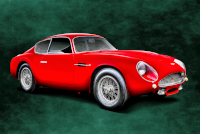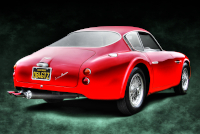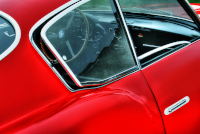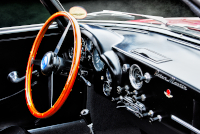Location:
Pebble Beach Concours d'Elegance, 2009
Owner: Jerry & Dana Rosenstock | Encino, California
Prologue:
Part of the Zagato class at Pebble Beach in 2009, at the time I had adopted a four-frame approach to survey automobiles (at the very least), the wealth of possibilities being somewhat endless at such a venue. These images sat for a while, long enough for the car to change hands and change colors, though early on I had completed a version of the main quarter perspective, which I published to an earlier version of 12cylinders. Now that we're formally addressing Aston Martin, I'm happy to have a representative of the DB4 GT Zagato. I even like the California license tag, which I do not suppose runs with the car any longer. Please take into consideration that the owners are owners of record as of 2009, and not necessarily today.
- - - - - - - - - -
► Image Source: Nikon D200 (10.2 MP)
References:
- Noakes, Andrew. "Aston Martin DB, 70 Years" Quarto Publishing, London, UK. 2017. (Revised edition: White Lion Publishing, 2019) page 100-103
- Beazley, Mitchell. "Aston Martin: Behind the Wheel of a Motoring Icon" Evo Publications Limited, London, UK. Octane Media Limited, Octopus Publishing Group. 2017, page 48-51
- UltimateCarPage: The most reliable site provides specifications and details on nine chassis, (though not 0199/L), by Wouter Melissen, November 23, 2015.
- Aston Martin Zagato: An explanation of the Sanction II and Sanction III cars, as well as a registry of DB4 GT Zagato cars.
Under David Brown, Aston Martin dwelt on the concept of becoming the English Ferrari, an aspiration embodied by the DB4 GT and DB4 GT Zagato. While the former used Touring's Superleggera coachwork and over 300 horses to compete for road and race supremacy, a rare, Zagato-bodied version provided the final surge of lightweight, high-compression alchemy. Slightly more powerful and lighter than the already select Touring-bodied car, the Zagato became an anomaly within Aston Martin's limited range. Revered as the quickest and most spritely of the DB4 race-ready road cars, the DB4 GT Zagato still fell short of the Ferrari 250 GT SWB Berlinetta on the race track. Then from Jaguar, the new E-Type delivered astonishing looks and performance for far less coin. Depressed interest meant Zagato fulfilled 19 of the planned 25-car production run, creating a rarity among devotees.
Chassis #0199/L is the last of the original 19 DB4 GT Zagato cars built. Having started at #0200/R to convince sporting regulators of a completed run, production returned with chassis #0176/R, then marched forward, skipping six chassis in the process due to low demand.
While most DB4 GT Zagato cars bear subtle differences, there is a template. Chassis #0199/L follows the basic outline penned by Zagato's Ercole Spada, then 23 years old and newly hired by Elio Zagato. The DB4 GT berlinetta became one of Spada's first high-profile achievements, alongside work for Alfa Romeo and OSCA during his first year with the firm. As Aston Martin aimed the car at the Ferrari 250 GT SWB Belinetta, similarities abound in the proportions and silhouette.
Among these Zagato DB4 GT berlinettas, a few stand out. Chassis #0183/R is brutish compared to its siblings, a pudgy version of the original, delicate shape. Chassis #0190/L, the 1961 Turin Motor Show car, is uncommonly elegant, adding deft fins to a slightly elongated tail. And of course the original, #0200/R, incorporates a chrome strake along the flank. We could pick apart the remaining cars for small differences in the bonnet and wheel arches, though many, like #0199/L, appear largely similar at a glance, representative of the image most would envision.
Motor: 3,670 cc straight 6-cylinder, aluminum alloy block and head | 92 mm x 92 mm | 9.7:1 compression
Valvetrain: DOHC, 2 valves per cylinder, chain driven
Aspiration: triple Weber 45 DCOE carburetors
Power: 314 bhp at 6,000 rpm
Drivetrain: 4-speed gearbox, rear-wheel drive
Front Suspension: independent unequal length wishbones with coil springs, telescopic dampers, and anti-roll bar
Rear Suspension: live axle with coil springs, parallel trailing links, Watt linkage, and double-acting lever-arm shock absorbers
Architecture: steel platform chassis with aluminum body by Zagato's Ercole Spada
Kerb Weight: 1,160 kg (2,557 lbs)
Wheelbase: 2,362 mm (93 inches)
0-60: 6.1 seconds
Top Speed: 245 km/h (152.2 mph)
Etymology:
The 'DB' designation appeared in the post-War revival of Aston Martin under its new owner, David Brown. 'DB1' applies retroactively to the 2-litre sports model of the late 1940s. The official chronology begins with the DB2 series, (first of the successful production sports cars), followed by the DB3 series, (purpose-built for racing). Following the DB3 series, Aston Martin developed both the DBR1 and DBR2 for international motorsport, (each a very different car, despite similar appearances). In 1958, the DB4 series became the production successor to DB2 series, the first update to a road-going Aston in a decade, whereas its drivetrain also appeared in the DBR2. DBR2 development dovetailed into the DB4 GT, as Tadek Marek designed and developed the new 3.7 litre motor. The GT version of the DB4 features a revised twin-plug cylinder head and triple Weber 45DCOE carburetors, raising horsepower above the 300 mark, appropriate for competition. Of the race-bred DB4 GT cars, Aston Martin delivered a small sample to Zagato in hopes of creating an ultra-lightweight competitor to Ferrari. These Zagato cars ran slightly higher compression as well, creating the lightest, most powerful DB4 GT available. Pertaining to the chassis number, the '/L' appears to indicate left-hand drive, as right-hand cars in the series end '/R.'
Figures:
Aston Martin commissioned 25 DB4 GT berlinetta cars from Zagato, but ended the run short at 19 examples. High cost, particularly compared to a Jaguar E-Type, suppressed market demand. Chassis #0199/L is the last of the original series. Production actually began with #0200/R, which is the last chassis number in the series allotted to Zagato production, (beginning at number 0176/R). The order of completion is sleight of hand to fool sporting regulators into believing the homologated production run had been completed, when in fact the run would never be completed as originally planned. Note that in 1991, Aston Martin and Zagato finally did complete four of the originally unbuilt DB4 GT cars, (0192, 0196, 0197, and 0198), known as the Sanction II series. In 1998, Zagato developed a further two cars, dubbed Sanction III.
Value:
Two sources place the original 1960 asking price at £5,470, (more than $15,000). The following year, 1961, Jaguar's E-Type Coupe debuted at £2,196 (roughly $6,150). For 40% of the cost, one could own a car of similar performance with a more advanced chassis and postmodern styling. The DB4 GT Zagato would have appealed, but only converted sales for a few truly devoted (and wealthy) individuals. In 2005, four years before we encountered the car at Pebble Beach, chassis #0199/L appeared for sale at RM's Monterey Sports and Classic Car auction. Estimated at the time between $2,900,000 and $3,200,000, the car did not sell, though it has changed hands since.
English Berlinetta: Ercole Spada Designs the English Counterpoint to the Ferrari 250 GT SWB
Ercole Spada's berlinetta design mimics Scaglietti's 250 GT SWB Berlinetta, the car Aston Martin set in its sights. In profile and in proportion, the basic GT layout holds the form established early in the post-War era by Pinin Farina's Cisitalia 202 and those that followed, like Pinin Farina's exceptionally balanced Maserati A6 GCS/53 Berlinetta. But the tail end of the DB4 GT Zagato shows the greatest evidence of hommage to the 250 GT SWB, perhaps even a copy of the Ferrari. The broad rear window, equivalent taper of the hood, and twin vertical lights mounted within deftly integrated haunches all appear largely the same as Scaglietti's design from the previous year. Spada added rear windows however, shapes fit to the subtle curves in the shoulders behind the doors. Similar rear window shapes appear on later Zagato cars. On the Aston Martin, these are perspex in the interest of saving weight. Some cars, such as #0199/L, add a flattened berm around the rear wheel arch.
The nose and bonnet distinguish this GT as an English product in Italian clothes. The grille takes the iconic Aston Martin shape first developed on the DB2/4 Mark III, which of course carries through to 21st century cars. And the headlamps use clear covers instead of separate pods, a design that the standard production DB4 also adopted. Perhaps most pleasing, many DB4 GT Zagato cars use some form of triple-bubble bulge on the bonnet, two large bulges indicating the twin-cam motor underneath with a third, smaller pop nestled ahead and in between. (A few of these Zagato cars instead use a flat hood scoop.) Most DB4 series cars include a long, oval duct below the grille, probably to aid oil pan cooling. The driving lights seen here on #0199/L in 2009 appear to have been added sometime after 2005, and were removed sometime prior to 2015 when the car appeared at Amelia Island, sans lights, wearing green paint.
Luxury Cabin: DB4 GT Interior Appointments
The gauge cowl matches the shape of the grille, a cue first seen on the DB2/4 Mark III, when the grille itself arrived. Aston Martin manufactured the horn button from a Bakelite material, set with the iridescent blue medallion and stylized "DB" script seen on 1960s cars. Compared to the tall stick of the Ferrari 250 GTO, topped by a large billiard ball of a head, the Aston Martin's shift lever is thin, with a palm-of-your-hand wine-stopper at the top. This gear-change mechanism is somewhat telling of the delicate balance attributed to the car—contrast to the large steering wheel—which is not to say that everything about the car's handling is delicate, but that the inputs, whether heavy or light, are properly matched. The DB4 GT Zagato did not achieve racing success, not as intended, but garnered a reputation as a fine driving automobile.
Last Updated: Mar 26, 2025




